Podcast Ep.5 Heads In The Clouds
Our smart phones would be pretty dumb without cloud connectivity. Just how clean and green is this 'cloud' that powers our digital lives?
It’s in our DNA to modify our environment and use tools to extract the choicest foods from it as easily as possible. Extinction from both suppression of unwanted and overexploitation of wanted species is what we do. How can we work together to a halt to Earth’s sixth great extinction event?
It's no secret that wildlife across the globe is being squeezed to extinction by human behaviour. There is very little mammalian wildlife left. The only problem with the picture below is that it doesn't show how rapidly we continue to make life impossible for wildlife in order to make room for ourselves, our mobile phones and the animals we eat.
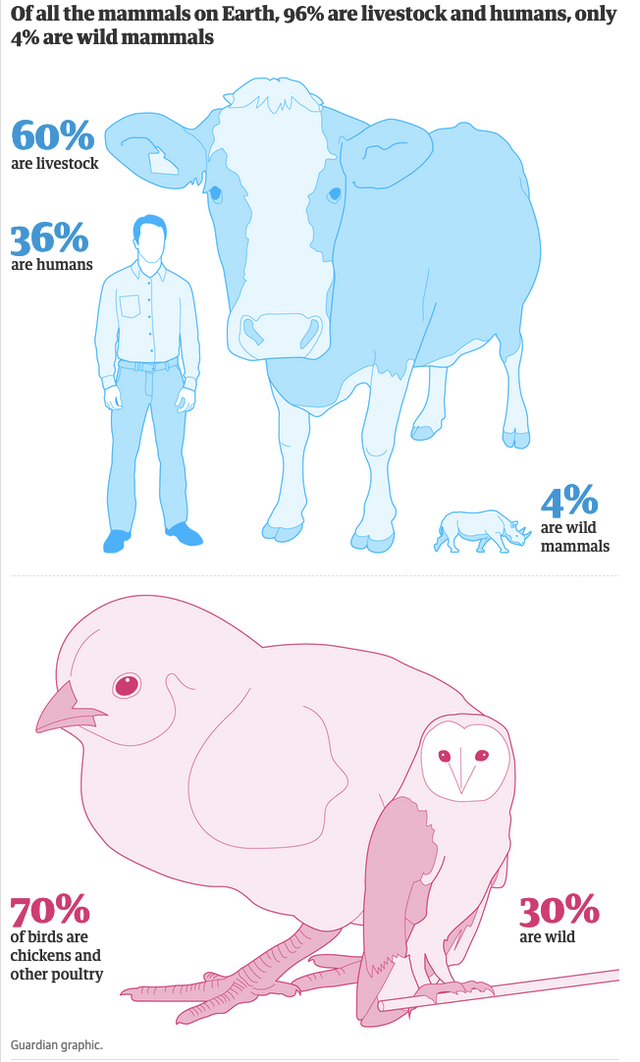
Only a third of the 4 billion hectares of the world’s forests are ecologically intact. Yet virgin forest destruction continues unabated. Some 20-25,000 square kilometres of forest is destroyed across the globe every year. Fire, timber cutting, mineral extraction and agriculture (cattle, palm oil and soy) contribute roughly equally to the destruction.
In the Amazon: deforestation fell from over 20,000 square kilometres per year in the early 2000s to a low of 5,000 in the early 2010s. Unfortunately the deforestation rate has risen again to over 10,000 square kilometres in recent years.
Efforts to reduce deforestation for palm oil in Indonesia has seen palm oil producers simply move operations to West Africa and continue clearing there. Here Down Under, fire and tree felling for wood products was responsible for roughly half each of our 1,300 square kms of deforestation in 2020.
As for grasslands, same tune, but different time scales. Most grasslands on most continents, be they American prairies and pampas, African savannahs, Euroasian steppes or Australian pasturelands (as discussed in the beef with beef post) were turned over to cropping and livestock grazing well before the turn of the 21st Century. As such, soil erosion, dry land salinity and deliberate eradication, if not extinction, of native grassland species have already wreaked havoc upon these ecosystems.
And the kidneys of ecosystems? Swamps and marshes have been drained since the advent of civilisation. Draining the source of endemic diseases such as malaria did seem to make sense. The recognition of their ecological importance only emerged recently.
The sixth mass extinction
The combined effects of habitat destruction and ongoing wildlife exploitation are the principal drivers of our planet’s current species extinction rate of 27,000 species per year. Climate change will likely become an equal driver over the coming decades. Plastic and pesticide pollution won’t help either. Together these forces are expected to drive half of all known species of plant or animal to extinction by the end of the century. Do we want a world of just cows, cockroaches and us?
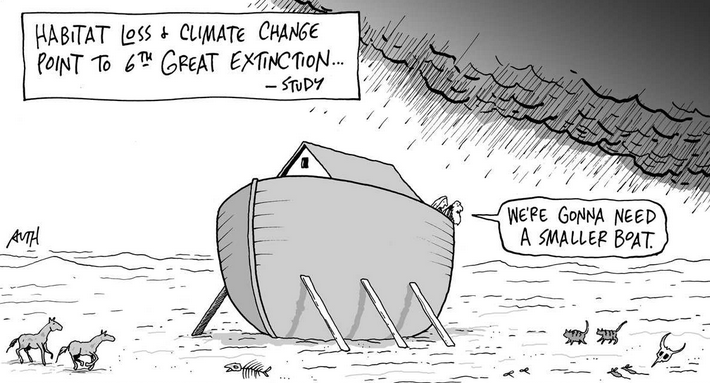
Our current mass extinction event is the sixth in the story of life on Earth. The worst in that story prior to ours was the Permian mass extinction event. Like today’s mass extinction, the Permian event was associated with global warming and high atmospheric CO2 levels. The vast majority of life forms on Earth died out. Unlike now, the Permian event occurred over 100s of thousands of years, not a mere 150-200 years. The rapidity of our destruction of species is unprecedented. A sad talisman here in Australia is the Bogong moth. The population has collapsed to less than half a percent of three years ago due to the effects of drought, light pollution and pesticide pollution. Koalas are not far behind.
Can we change course?
It is blindingly obvious we need to be less rapacious of natural resources in order to reduce extinction rates. The question is what changes will make the most difference quickly?
Only a fifth of the world’s palm oil supply is produced sustainably and the world’s addiction to it continues to grow. So limiting unsustainable palm oil would appear a good place to start. Just saying no to palm oil based Ferrero Rocher and Nutella won’t actually do a great deal, as illustrated below. Everything from everywhere makes it very hard for the global North to say no to palm oil. For the growing global South population there is no alternative cheap, easy to obtain, less land-intensive, cooking oil.
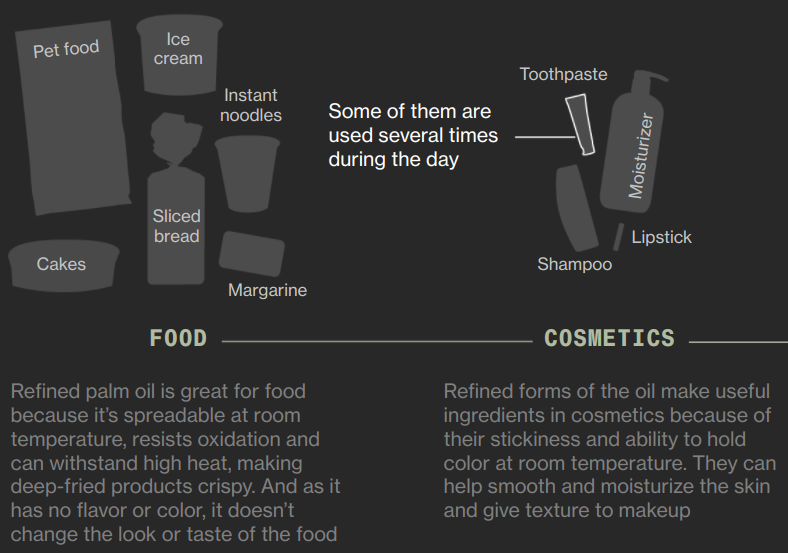
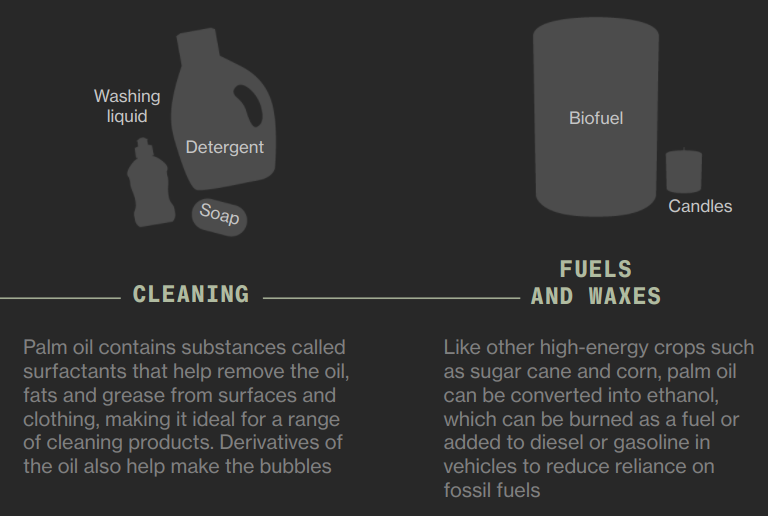
An ‘easier’ target appears to be livestock. It is difficult to see how any room can be made for wildlife without restricting global meat production. And there are sound health as well as environmental reasons to turn the tide on the world’s ever increasing consumption of meat. Reducing the world’s livestock population, let's say, by one third, would create much needed lebensraum to actively re-wild and thereby preserve some biodiversity in the decades ahead.
The current UN policy calls for a ‘30 by 30’ approach. That is, stringent conservation of 30% of global land and seas by 2030 in order to protect species.
As catchy as ‘30 in 30’ is, the slight problem with this approach is that it would likely lead to human starvation in many parts of the globe. This fact alone makes the policy unimplementable in many globally important biodiversity hotspots. The policy may not provide sufficient protection for many species of wildlife anyway. Think of the red necked stint that flies 26,000 Km between Siberia and the Swan River in Western Australia every year. Environmental protection is needed in both Russia and Australia.
And what do we actually mean by ‘wild’ or ‘natural’ environments? The migratory birds visiting Perth, (population roughly 2 million) in Western Australia are not visiting an undisturbed environment but wading beside an 8 lane freeway.
Apart from Antarctica, which we didn’t reach until quite recently, humankind and our forebears have been modifying environments since Homo first picked up a tool. Across the globe for at least the last million years or so it appears our forebears as well as us have hunted the easiest, largest and tastiest species to extinction. We have also curated the planet's plant life to suit ourselves. In the Amazon the tree species that provide the tastiest fruits or other important resources are the species given favour. Australia has been modified by human lit fires for the best part of 60,000 years in order to encourage open spaces for game hunting and the soils dug to grow yam daisies rather than other species.
It's in our DNA to modify our environment and use tools to extract the choicest foods from it as efficiently as possible. Extinction from both suppression of unwanted and overexploitation of wanted species is what we do.
An integrated land use strategy that keeps locked away what we have already locked away, but recognises locking away more will likely be unsustainable owing to global food crises or other economic factors has been suggested as an alternative to 30 in 30. In a small way, the destocking and restoration of pasturelands is an illustration of such a strategy. Native grasslands and the species they support have returned to Wooleen Station. The creeks run clear rather than red with eroded soil. Dingos are not hunted or poisoned but help control the kangaroo population. This isn’t Nirvana but surely better than destructive monoculture.
Moving the policy dial
Whichever policies are likely to make the biggest difference to our appalling extinction rates, perhaps the thorniest issue is their timely and effective implementation.
An in-your-face approach like Extinction Rebellion (XR) is motivated by the sheer scale and urgency of species loss we are causing. While the passion is undeniable, it is questionable as to whether the approach is cutting through. Stopping traffic may be sufficient to get on the TV news and social media feeds. This exposure may be sufficient to draw traffic to the XR website. But the XR website doesn’t offer much in terms of specific policy action that governments or individuals can adopt to halt extinctions. The approach is also unlikely to connect with a large proportion of the population who are not already engaged with climate or environmental issues.

This lack of specificity can be contrasted to the 8 hour day movement of the second half of the 19th century. Equally in your face to XR, the demand was clear, as was how to implement it and measure its implementation and success.
The complexity of halting extinctions requires additional approaches to move policy discussion and action across whole populations and their governments. Rapid changes in policy positions are often only made after an existential (to humans), very visible and preferably visual, fast emerging threat. The Eastern Australian summer bushfires of 2019-2020 ticked all these boxes and did appreciably change the nature of the national climate policy debate. But only after the event and at the expense of 3 Billion creatures.
We need to do better than waiting for another highly visible disaster. There have been other issues of comparable complexity to the extinction crisis that have been dealt with in the past. It is important to learn what we can from them. Examples include smoking reduction, ozone and pesticide policy.
The collective action by nations to limit damage to the Ozone layer is rightly considered a great environmental success. Like the 8 hour day, a singular clear and measurable action, the reduction of use of chlorofluorocarbons was required rather than the complex set of issues that need to be managed to halt species extinctions worldwide. Even with this clarity, it took the best part of a decade to implement across most nations. Negotiation for the Montreal Protocol commenced in 1983 before the protocol was agreed in 1987. Trade sanctions against laggard nations were only implemented in 1993.
The story for pesticides is more complex. There have been some successes, notably bans against the use of organophosphate pesticides that persist in the environment and are concentrated in mammalian fat, such as DDT and Dieldrin. Bans and sanctions against use of other pesticides with significant environmental consequences, such as neonicotinoids, are being adopted inconsistently with active promotion of use in the global South. An internationally consistent approach to usage remains elusive.
Smoking policies have some similarities to pesticides. There is no international consistency and active promotion of smoking in the global South. Where success has been achieved, such as Australia or California, the principal strategy has been denormalising smoking as a behaviour.
The methods of achieving denormalisation of smoking were manyfold and needed to be pursued across time and jurisdictions. They included banning advertising, commercial and public space smoking bans, occupational health and safety laws, age limits on purchases and health education. Once smoking as a norm ceased being reinforced, smoking rates declined. Vigilance is required to prevent the policies being rolled back.
Can we stop buying extinction?
We have a society which has normalised the consumption of the drivers of wildlife extinction. Whether it is the extraction of raw material for the mobile phones or SatNavs in a car, ubiquitous ‘disposable’ single use containers for everything from sliced oranges sold in supermarkets to take away coffee cups, palm-oil based hair shampoo, disposable flat pack furniture or fast fashion; almost every aspect of our lives are enmeshed in supply chains that increase extinction rates.
If we are serious about limiting extinctions we need to consume LESS and make do with what we have already MORE. Denormalising consumption of anything disposable or with a short useful life would be a start. Can XR start picketing IKEA and H&M please and clearly explain why? Denormalising fast food and daily meat consumption has both health and wildlife benefits. As for palm oil...a leaf from the ozone or pesticide playbooks is likely needed. Bans, sanctions and tariffs by the global North would be a good start but unlikely to happen overnight.
Of course, successfully prosecuting any of these strategies challenges powerful actors who erroneously believe they are benefiting from the status quo despite the fact they too are humans who benefit from global biodiversity. These actors, as First Dog on the Moon explains below, are promulgating laws to stifle dissent.
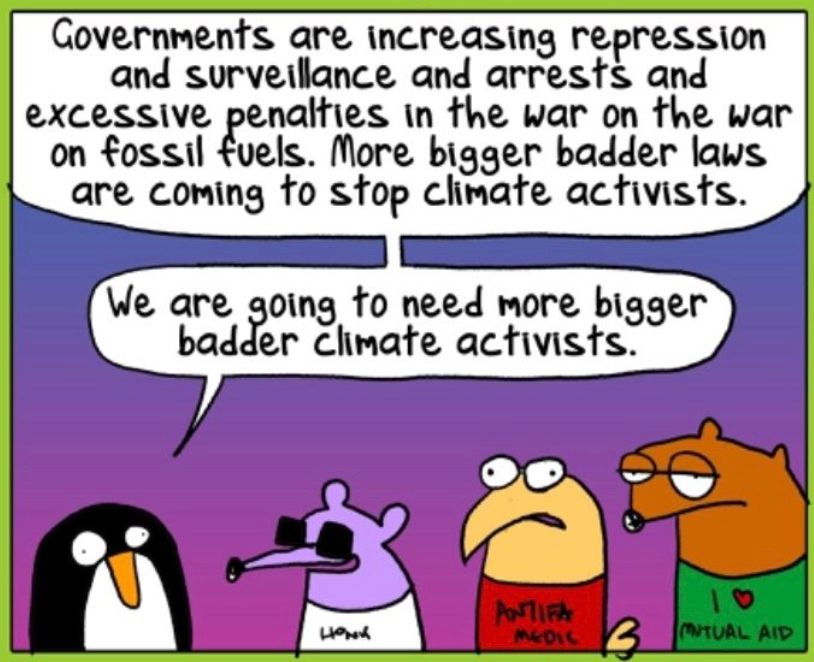
Ultimately, moving the dial means replacing parliamentary representatives who are failing us and the world's species with representatives who will make a difference. The video link below explains how...
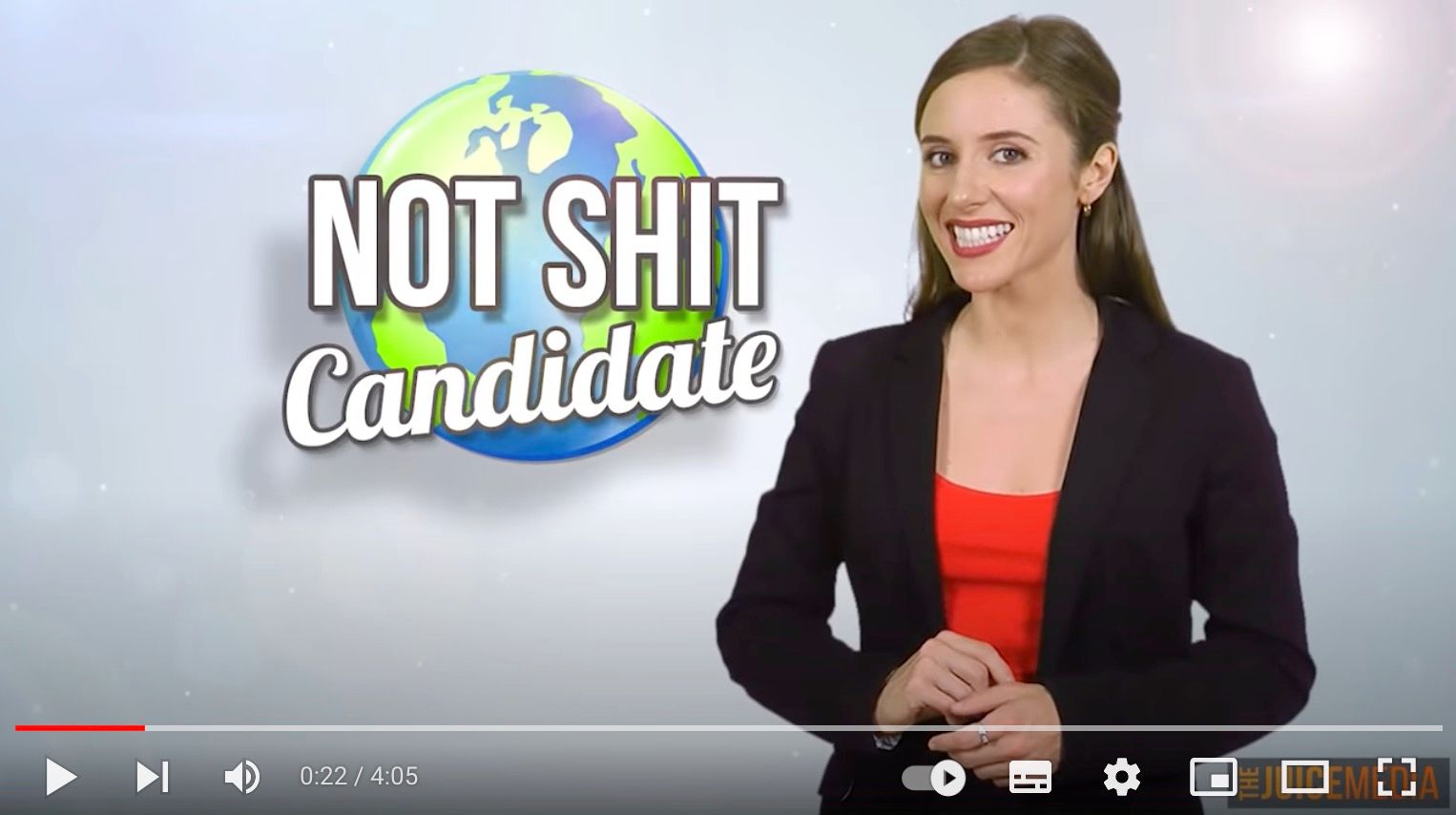
Subscribe to thisnannuplife.net FOR FREE to join the conversation.
Already a member? Just enter your email below to get your log in link.